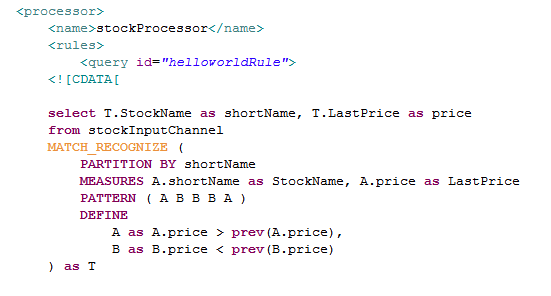Oracle Event Processing – Pattern Matching Example
Event processing technologies became famous in recent years. Companies realizes that they need to take real time action in order to satisfy customer requirements or handle several component issues happened in some internal system or advertising etc.
Oracle Event processing has several processing methods in order to process incoming real time data. In this blog post I will show off one of the pattern matching operations.
Consider, you desire to find out which stock firstly increases then decreases three times and increases again. For example;
6.48;6.47;6.46;6.48;6.49;6.48;6.47;6.46;6.47;6.46;6.45;6.44;6.43;6.42;6.43
In the above numbers we will find out the pattern which starts with 6.48 and ends with 6.47. Because it firstly incremented from 6.48 to 6.49 and then decreased three times ( 6.48,6.47,6.46 ) and then increased from 6.46 to 6.47 again.
I am using the Oracle Event Processing 11.1.1.7 for Windows 64bit and Cygwin as windows terminal.
I changed a little bit the HelloWorld default cep application. The most crucial part is the CQL Processor part, how should I implement the CQL in order to find out the patterns?
Let’s look at the clauses in briefly.
StockProcessor is the name of the cql processor.
PARTITION BY shortName: Partition incoming data by shortName ( CQL Engines calculates each partition individually. For example, ORCL, IBM, GOOG prices are computed individually. )
MEASURES : Which values, fields will be in the output
PATTERN : Order of conditions ( Look at regular expression for more details )
DEFINE : Defining the conditions, “A as” means the define condition A.
Run the application and type the stock name and prices as in below:
Just after pattern is matched the output event is produced and in this example I just printed the name and last price value of the stock.
I didn’t specify any performance measurements but if the number of distinct stocks are increased performance will be our first concern. However, I would like to share some performance results in a another blog post later.
-
April 5, 2013 at 10:39 pmOracle Event Processing – Pattern Matching Example 2 | A. Fuat Sungur's Blog

